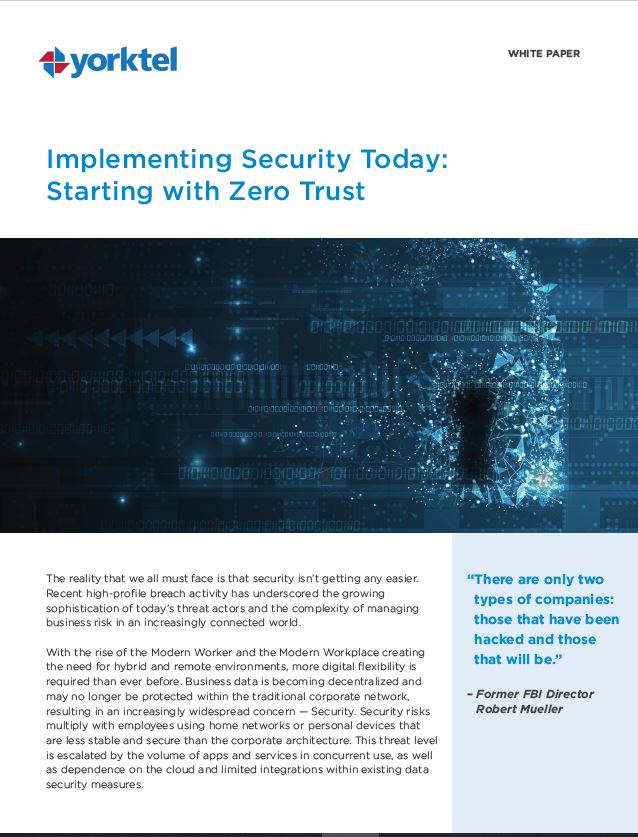Zero Trust has become one of the hottest buzzwords in cybersecurity. But what does Zero Trust mean and why should enterprises be looking to implement a Zero Trust strategy going forward?
What Does Zero Trust Mean?
Zero Trust security treats all requests to the network as if they’re a threat — both internal and external requests, alike. Everyone who needs access must go through the same security measures as if it’s the first time they’ve made the request. In practical application, that means that all users — in the enterprise and those outside — must be continuously authenticated and validated to continue to access applications. It also assumes no traditional network edge and must consider local, cloud, and hybrid configurations as part of the security strategy.
The National Institute of Standards and Technology (NIST) recommends a Zero Trust strategy as a best practice to address security challenges particular to the enterprise. Zero Trust could be the best way forward as they explore remote work, a distributed workforce, and cloud-first frameworks.
Zero Trust operates on three basic principles:
- Validate all devices: No matter what the device is or who issues it, if it asks for access to the network, it needs security—passwords bolstered by multi-factor authentication.
- Verify all users: Besides MFA password support, machine learning and artificial intelligence tools can also add behavioral-based access scrutiny.
- Intelligent governance: A deep understanding of who has access, for how long, and why, should underpin any security strategy.
How To Implement Zero Trust Security In Five Steps
Enterprises should understand their current security position and begin implementing changes to embrace a Zero Trust model moving forward. Here’s how to make these Zero Trust principles a reality:
- Define your protect surface: The first step in implementing Zero Trust security is to define your protect surface. A protect surface includes everything that’s valuable to your enterprise and usually comprises data, assets, applications, and services, sometimes referred to as DAAS. It’s basically everything that needs protecting to ensure the continued operation of your organization.
- Understand and map the protect surface’s transaction flows: By mapping the protect surface’s transaction flows i.e. the interactions that occur between your critical DAAS elements, your organization can build up a clearer picture of the interdependencies that exist. A security policy can then be drawn up that only allows authorized users and devices to access certain data and assets.
- Architect the Zero Trust network: Once all of your organization’s transaction flows have been identified, the Zero Trust network can then be architected. It will be based on allowing all necessary transaction flows and blocking everything else.
- Create your Zero Trust policy: The penultimate step is to implement a next-generation firewall around the protect surface’s perimeter. The ‘Who? What? When? Where? Why? How?’ system, also known as the Kipling Method, can then be used to determine which users and devices should be allowed to access protected areas. The firewall is then programmed to grant or deny access accordingly.
- Monitor and maintain the Zero Trust network: With the Zero Trust network in place, your admins should then continuously review all the logs and monitoring available to them to identify any issues, as well as potential improvements. Zero Trust is an iterative process, which makes this final step essential for your organization’s ongoing network security.

Implementing a Zero Trust strategy
Download this whitepaper to discover the steps you should take to implement a Zero Trust Security approach within your organization, helping protect you from cyber-attacks.
Why Zero Trust Is Essential
As companies adopt more Internet of Things (IoT) devices, distributed networks, and a remote or flexible workforce, traditional security strategies will no longer keep pace to ensure the enterprise remains safe. To assume that every action on the network is a potential threat is the only way to maintain the enterprise’s security.
Perimeter-based security isn’t enough
Digital technologies change constantly. Threats evolve. Enterprises have adopted flexible operations and need a security strategy that addresses that evolution. Zero Trust operates at an almost granular level, examining each point along the access chain to find out who makes requests and what devices are active.
Granular governance also helps should a breach occur. The system can minimize damage and limit the spread throughout the network because each point is also undergoing constant scrutiny. Without this level of granularity, companies spend a lot of time chasing and reacting to threats and not enough time preventing them.
Security must consider third-party access
Software as a Service (SaaS) and Platform as a Service (PaaS) — where applications and hardware tools are delivered to users over the internet — are increasingly popular. While these third-party solutions offer many benefits, they must also go through the same level of scrutiny as other enterprise tools. Zero Trust assumes that the network is already compromised because developers rely on third-party solutions to build their own applications — nothing is above scrutiny.
In addition, remote work happens over the internet, which is itself an open and untrustworthy network. When an enterprise adopts any level of remote work, it will occur over this unsecured network. Operating on the principle of always verifying access helps the enterprise work within this new parameter.
Without Zero Trust, companies may not have the right security guarantees in place from their third-party partners. That leaves huge holes in their security framework. Zero Trust ensures that even gaps in third-party security do not affect the enterprise’s overall security strategy.
Building a Zero Trust security framework
A Zero Trust network is the way forward for enterprises in the remote work era. It allows for flexible operations without sacrificing safety and ensures that enterprises have their assets under control without stymying operations and productivity.
Contact Yorktel to learn more about how a Zero Trust strategy can transform your organization’s security.
